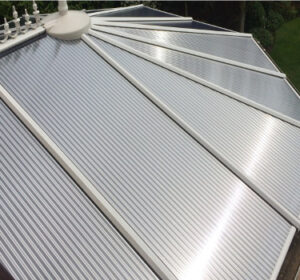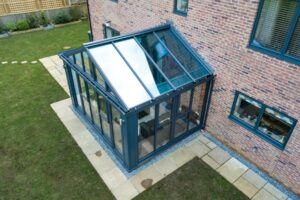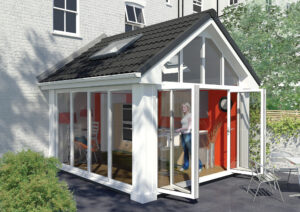- 4 February 2025|
- Conservatories
When’s the right time to update your conservatory roof?
Upgrading your conservatory roof can feel like a significant decision, but when timed right, it can offer a host of benefits like improved efficiency which can make your conservatory suitable for use all year round. Over time, even the most well-built conservatory roofs can begin to show signs of wear, impacting your home’s comfort and value. So, how do you know when it’s the right time to take the plunge? This article explores the factors to consider when deciding whether to upgrade your conservatory roof, including the types of replacement options available and the key benefits of making the change.
Spotting the Signs of an Outdated Roof
Temperature Troubles
Does your conservatory turn into a sweltering greenhouse during summer and an icebox in winter? Consistent temperature swings suggest poor insulation—an immediate clue your roof may be past its prime.
Visible Wear and Tear
Cracks, discolouration, and leaks are clear signs of a deteriorating roof. Keep an eye out for mould growth, water stains, or even small damp patches that appear when it rains. These issues not only affect comfort but can also lead to more serious structural problems down the line.
Sky-High Energy Bills

Many older roofs (especially polycarbonate) lose heat quickly in colder months. If your heating bills are steadily rising and you suspect your conservatory is partly to blame, it might be time to consider a more energy-efficient roof replacement.
Benefits of Upgrading Your Conservatory Roof

Upgrading your conservatory roof can bring a range of advantages, making your living space more comfortable and efficient. Let’s explore the key benefits of a roof upgrade and how it can improve both your home’s value and your everyday experience.
Enhanced Energy Efficiency
One of the most significant reasons homeowners choose to upgrade their conservatory roofs is to improve energy efficiency. Traditional polycarbonate or older glass roofs often struggle to retain heat in winter and block excessive warmth in summer. This leads to uncomfortable extremes, making the conservatory unusable for large parts of the year. Modern roof options, such as lightweight tiled roofs or double-glazed glass, offer vastly improved insulation. This upgrade can result in lower energy bills, as your conservatory becomes a more consistent and comfortable environment year-round.
Improved Aesthetic Appeal and Value
A new conservatory roof doesn’t just enhance performance—it also transforms the look of your home. Whether you opt for a sleek glass roof or a traditional tiled design, the right roof can seamlessly blend with your home’s style, boosting its curb appeal. In addition, upgrading your roof can increase the overall value of your property. Potential buyers are more likely to be drawn to a well-maintained, energy-efficient conservatory that feels like a cohesive part of the house.
When deciding to upgrade your conservatory roof, it’s crucial to understand the different options available. Each type of roof offers unique benefits, so selecting the right one depends on your specific needs, budget, and desired aesthetics. Below are some of the most popular replacement roof types and their pros and cons.
Solid Roofs: Pros and Cons
Solid conservatory roofs are an increasingly popular option for homeowners looking to transform their conservatory into a year-round living space. These roofs typically consist of insulated panels covered with tiles or slate, offering excellent thermal efficiency and a more integrated appearance with the rest of your home.
Pros:
- Superior insulation, keeping the conservatory warm in winter and cool in summer.
- Provides a more traditional look that seamlessly blends with the existing architecture.
- Improved soundproofing, reducing noise from rain and wind.
Cons:
- Can be more expensive than other roof types due to the materials and installation process.
- Reduced natural light compared to glass or polycarbonate roofs, although skylights can be added to offset this.
Glass Roofs vs. Tiled Roofs

Glass and tiled roofs each have their advantages, catering to different homeowner preferences. A glass roof offers a bright, open feel, while a tiled roof prioritises insulation and a cohesive appearance.
Glass Roofs:
- Maximise natural light, creating an airy, open atmosphere.
- Modern double-glazed glass offers better insulation than older options.
- Available with UV protection and self-cleaning coatings.
Tiled Roofs:
- Excellent insulation, helping to maintain consistent temperatures.
- More closely resembles a standard roof, enhancing curb appeal.
- Comes in a variety of colours and finishes to match your home’s exterior.
